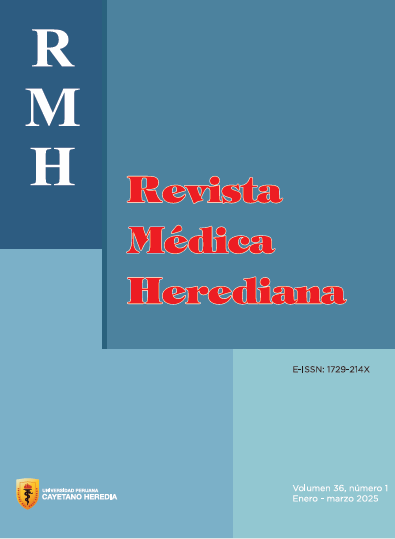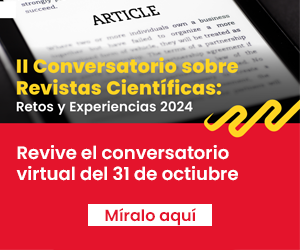High-fidelity simulation in sepsis and septic shock for medical students of a private university in Lima, Peru
DOI:
https://doi.org/10.20453/rmh.v36i1.6003Keywords:
Simulation, sepsis, septic shock, undergraduateAbstract
Objective: to evaluate the impact of a program on high-fidelity simulation on knowledge about sepsis and septic shock among pre-graduate medical students. Methods: A quasi-experimental study was conducted. Students received lectures on sepsis and septic shock before the simulation sessions. Two sessions were scheduled, one on sepsis due to an upper urinary tract infection (scenery A) and the second one about septic shock due to nosocomial pneumonia (scenery B). A pre-and post-test was scheduled, and a debriefing was guided by a checklist to evaluate the achievement of the learning objectives. Results: 153 students participated; the mean score of the post-test was higher than the pre-test (0.97± 0.06 vs. 0.90 ± 0.14 p<0.00). The most right topic in the pre and post-test was determining gold time in sepsis and septic shock (98% on the pre-test and 100% on the post-test). The less correct item on the checklist was the evaluation of diuresis (50% and 35%, respectively). Conclusions: High-fidelity simulation sessions improve pre-graduated medical students' knowledge of sepsis and septic shock.
Downloads
References
Riancho J, Maestre JM, del Moral I, Riancho JA. Simulación clínica de alto realismo: una experiencia en el pregrado. Educ.méd. 2012; 15(2):109-115. (Citado el 30 de enero del 2022) Disponible en: http://scielo.isciii.es/scielo.php?script=sci_arttext&pid=S157518132012000200009&lng=es
Raurell-Torredà M, Gómez-Ibañez R; Miembros grupo GRISCA (Grup Recerca en Simulació a Catalunya i Andorra). High-fidelity simulation: Who has the most impressive laboratory? Enferm Intensiva. 2017; 28(2):45-47. doi: 10.1016/j.enfi.2017.04.001.
Armenia S, Thangamathesvaran L, Caine AD, King N, Kunac A, Merchant AM. The Role of High-Fidelity Team-Based Simulation in Acute Care Settings: A Systematic Review. Surg J (N Y). 2018;4(3): e136-e151. doi: 10.1055/s-0038-1667315.
Geis GL, Wheeler DS, Bunger A, Militello LG, Taylor RG, Bauer JP, Byczkowski TL, Kerrey BT, Patterson MD. A Validation Argument for a Simulation-Based Training Course Centered on Assessment, Recognition, and Early Management of Pediatric Sepsis. Simul Healthc. 2018;13(1):16-26. doi: 10.1097/SIH.0000000000000271.
Rhodes A, Evans LE, Alhazzani W, et al. Surviving Sepsis Campaign: International Guidelines for Management of Sepsis and Septic Shock: 2016. Intensive Care Med. 2017;43(3):304-377. doi: 10.1007/s00134-017-4683-6.
Yang CW, Ku SC, Ma MH, Chu TS, Chang SC. Application of high-fidelity simulation in critical care residency training as an effective learning, assessment, and prediction tool for clinical performance. J Formos Med Assoc. 2019;118(9):1347-1355. doi: 10.1016/j.jfma.2018.12.003
Vattanavanit V, Kawla-Ied J, Bhurayanontachai R. High-fidelity medical simulation training improves medical students' knowledge and confidence levels in septic shock resuscitation. Open Access Emerg Med. 2016; 9:1-7. doi: 10.2147/OAEM.S122525.
Fernández-Ros N, Alegre F, Huerta A, et al. Acquiring sepsis competencies through simulation-based learning bundle during intermediate care unit internship. Medicine (Baltimore). 2021;100(5): e24483. doi:10.1097/MD.0000000000024483
Lighthall GK, Bahmani D, Gaba D. Evaluating the Impact of Classroom Education on the Management of Septic Shock Using Human Patient Simulation. Simul Healthc. 2016;11(1):19-24. doi: 10.1097/SIH.0000000000000126
Littlewood KE, Shilling AM, Stemland CJ, Wright EB, Kirk MA. High-fidelity simulation is superior to case-based discussion in teaching the management of shock. Med Teach. 2013;35(3):e1003-10. doi: 10.3109/0142159X.2012.733043
Nguyen HB, Daniel-Underwood L, Van Ginkel C, et al. An educational course including medical simulation for early goal-directed therapy and the severe sepsis resuscitation bundle: an evaluation for medical student training. Resuscitation. 2009; 80(6):674-9. doi: 10.1016/j.resuscitation.2009.02.021
Ottestad E, Boulet JR, Lighthall GK. Evaluating the management of septic shock using patient simulation. Crit Care Med. 2007;35(3):769-75. doi: 10.1097/01.CCM.0000256849.75799.20
Schroedl CJ, Corbridge TC, Cohen ER, et al. Use of simulation-based education to improve resident learning and patient care in the medical intensive care unit: a randomized trial. J Crit Care. 2012;27(2): 219.e7-13. doi: 10.1016/j.jcrc.2011.08.006.
Williams JB, McDonough MA, Hilliard MW, Williams AL, Cuniowski PC, Gonzalez MG. Intermethod reliability of real-time versus delayed videotaped evaluation of a high-fidelity medical simulation septic shock scenario. Acad Emerg Med. 2009;16(9):887-93. doi: 10.1111/j.1553-2712.2009. 00505.x
Hänsel M, Winkelmann AM, Hardt F, et al. Impact of simulator training and crew resource management training on final-year medical students' performance in sepsis resuscitation: a randomized trial. Minerva Anestesiol. 2012;78(8):901-9.
Davis AH, Hayes SP. Simulation to Manage the Septic Patient in the Intensive Care Unit. Crit Care Nurs Clin North Am. 2018;30(3):363-377. doi: 10.1016/j.cnc.2018.05.005.
Cortegiani A, Russotto V, Montalto F, et al. Effect of High-Fidelity Simulation on Medical Students' Knowledge about Advanced Life Support: A Randomized Study. PLoS One. 2015;10(5): e0125685. doi: 10.1371/journal.pone.0125685.
Norcini JJ. Work based assessment. BMJ. 2003;326(7392):753-755. doi:10.1136/bmj.326.7392.753
Rogers PL, Jacob H, Rashwan AS, Pinsky MR. Quantifying learning in medical students during a critical care medicine elective: a comparison of three evaluation instruments. Crit Care Med. 2001;29(6):1268-1273. doi:10.1097/00003246-200106000-00039
Downloads
Published
How to Cite
Issue
Section
License
Copyright (c) 2025 Guiliana Mas Ubillús, Karla Tafur Bances , Diana Fernandez Merjildo

This work is licensed under a Creative Commons Attribution 4.0 International License.
Authors assign their rights to the RMH so that may disseminate the article through the means at their disposal. The journal will provide forms of affidavit of authorship and authorization for the publication of the article, which shall be submitted with the manuscript. Authors retain the right to share, copy, distribute, perform and publicly communicate their article, or part of it, mentioning the original publication in the journal.




















